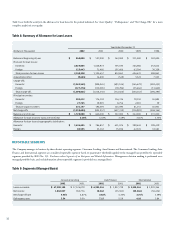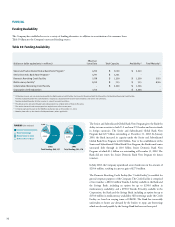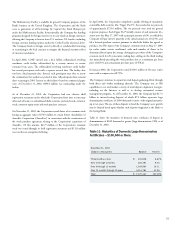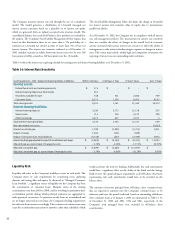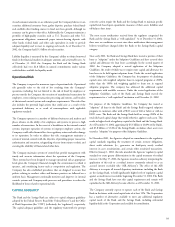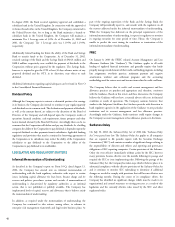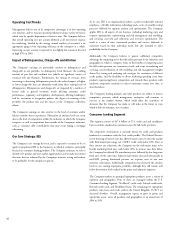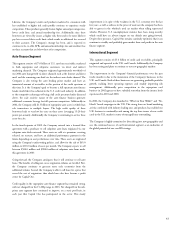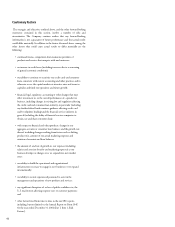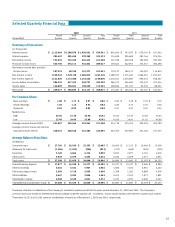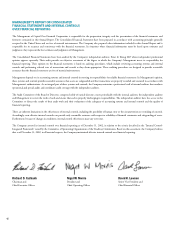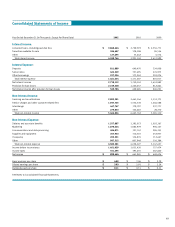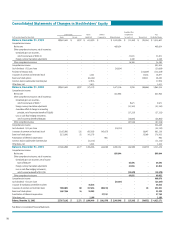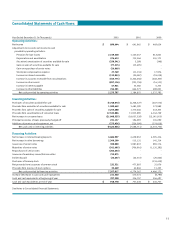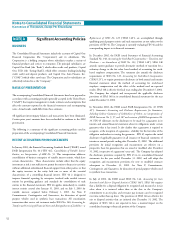Capital One 2002 Annual Report Download - page 44
Download and view the complete annual report
Please find page 44 of the 2002 Capital One annual report below. You can navigate through the pages in the report by either clicking on the pages listed below, or by using the keyword search tool below to find specific information within the annual report.
42
At its core, IBS is an organizational culture, a pool of analytically oriented
employees, a flexible information technology and a series of scientific testing
processes followed by rigorous analysis and optimization. The Company
applies IBS to all aspects of our business, including marketing copy and
response optimization, underwriting and risk management and modeling,
and servicing, cross-sell, and collections and recoveries optimization. The
result is a series of mass customized products and services delivered to
customers based on their individual needs, but also intended to drive
profitability for the Company.
Additionally, the Company believes it garners additional competitive
advantage by competing across the full credit spectrum in the industries and
geographies in which it competes. Some of the benefits of competing across
the full credit spectrum are economies of scale and scope in marketing and
servicing, cross-fertilization of risk modeling and risk management insights
derived by testing and analyzing risk strategies for customers of different
credit quality, and the flexibility to divert marketing spending away from
products experiencing heavy competition and towards those products with
moderate competitive intensity in order to maximize returns over time, as
described above.
The Company’s lending products and other products are subject to intense
competitive pressures which management anticipates will continue to
increase as our markets mature, which could affect the economics of
decisions that the Company has made or will make in the future in ways
which it did not anticipate, test or analyze.
Consumer Lending Segment
This segment consists of $47.4 billion of U.S. credit card and installment
loan receivables, marketed to customers across the full credit spectrum.
The competitive environment is currently intense for credit card products
marketed to consumers with the best credit profiles. The Federal Reserve’s
recent lowering of interest rates has allowed many issuers to enter the market
with fixed annual percentage rate (“APR”) credit cards below 10%. Prior to
these interest rate reductions, the Company was the only major issuer to be
heavily marketing fixed rates cards below 10%. As interest rates have fallen,
the Company has offered 0% introductory rates, followed by low long-term
fixed rates. At the same time, industry mail volume increased substantially in
mid-2002, putting downward pressure on response rates to our new
customer solicitations. Additionally, competition has increased the attrition
levels in our existing superprime portfolio, although they still remain well
below the attrition levels realized in the prime and subprime segments.
The Company markets six principal superprime products across a variety of
segments and geographies. Four of these are managed within the U.S.
Consumer Lending Segment: “No-Hassle” credit cards, Lifestyle credit cards,
Rewards credit cards, and Installment loans. The remaining two superprime
products, auto loans and credit cards in the United Kingdom (“U.K.”) are
discussed elsewhere. Overall, management expects to grow its prime and
superprime assets, across all products and geographies, at an annual rate of
20% to 25%.
Operating Cost Trends
Management believes one of its competitive advantages is its low operating
cost structure, and we measure operating efficiency using a variety of metrics
which vary by specific department or business unit. The Company believes
that overall operating cost per account (defined as all non-interest expense
less marketing, divided by the average annual number of accounts) is an
appropriate gauge of the operating efficiency of the enterprise as a whole.
Operating cost per account is expected to rise slightly but remain in the mid
to high $70’s in 2003.
Impact of Delinquencies, Charge-offs and Attrition
The Company’s earnings are particularly sensitive to delinquencies and
charge-offs in our portfolio. As delinquency levels fluctuate, the resulting
amount of past due and overlimit fees (which are significant sources of
revenue) will also fluctuate. Furthermore, the timing of revenues from
increasing or decreasing delinquencies precedes the related impact of higher
or lower charge-offs that can ultimately result from these varying levels of
delinquencies. Delinquencies and charge-offs are impacted by a number of
factors such as general economic trends affecting consumer credit
performance, regulatory and legislative developments affecting bankruptcy
and fee assessment or recognition policies, the degree of seasoning of the
portfolio, the product mix and the success of the Company’s collections
efforts.
The Company’s earnings are also sensitive to the level of customer and/or
balance attrition that it experiences. Fluctuation in attrition levels can occur
due to the level of competition within the industries in which the Company
competes, as well as competition from outside of the Company’s industries,
such as consumer debt consolidation that may occur during a mortgage
refinancing.
Our Core Strategy: IBS
The Company’s core strategy has been, and is expected to continue to be, to
apply its proprietary IBS to the businesses in which it competes, principally
focused on consumer lending products. The Company continues to seek to
identify new product and new market opportunities, and to make investment
decisions that are informed by the Company’s intensive testing and analysis
to be profitable, for the enterprise to pursue.


